Arts & Sciences Entries

What is the entry?: Painting of a Viking pendant
Where would it be found?: The pendant was made over 1,000 years ago by Vikings. In Sweden. That’s on the other side of the planet. The real pendant is made out of silver. Silver comes from the ground out of rocks. To make silver jewelry, you break up the rocks, melt the silver, and pour it into a mold. Vikings stole silver, they’d melt it, and make it into new treasure.
What materials did you use?: My mom’s paints and brushes. Paper. I used acrylic paints. They’re made of chemicals and, stuff. Our ancestors had other paint. Made out of ground up rocks. Or ash. Our ancestors would pee on copper and it would turn green and you scrape it off and mix it with egg white to make green paint.
What was your source of inspiration for this entry?: I want to be the champion. I like Vikings and I want to be a Viking in the SCA.


What is the entry?: A Viking pendant made with beads
Where would it be found?: The pendant was in a bunch of Viking treasure found in a bog. I don’t know why the Vikings threw their treasure in a swamp. I wouldn’t do that!
What materials did you use?: Wire and beads. I used plastic and glass beads. Our ancestors didn’t have plastic. They made beads out of glass. And rocks. And wood, seeds, seashells…. and bones!
What was your source of inspiration for this entry?: My mom’s jewelry book that told us how to make this.



What is the entry?: Drawstring Leather Pouch
Where would it be found?: Anywhere in the world where people hunt animals. Anyone who wants to keep their treasures safe could have one.
What materials did you use?: Elk leather, leather string . The first thing I did was cut a circle of leather with scissors. Then I punched holes around the edges of my thing inside of the edges. I used a hole puncher you hold with your hand and hit with a hammer. Next, I put the string through the holes. Last, we tied the string ends together. The special thing and the cool thing is that when I pull the string, it closes up. My favorite part is the inside because it’s soft. It’s also a necklace. Leather can come from cows, deer, elk, moose, and pigs and more animals. That’s actually all.
What was your source of inspiration for this entry?: I wanted a bag for my treasure collection.

What is the entry?: Woodturning Lathe
Where would it be found?: In a Woodturners shop or on-site where trees were being felled
What materials did you use?: Douglas Fir and Period Tools
What was your source of inspiration for this entry?: A German spring pole lathe
Documentation: https://drive.google.com/file/d/1gnX-slilYhlszXdFK8Y33ltMdLNJ1O4q/view?usp=sharing
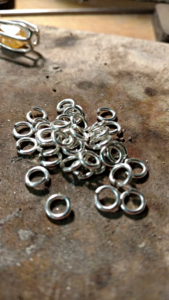


What is your Name?: Ramvoldus Köll
What is the entry?: Citrine Pendant
Where would it be found?: 14th Century Prague
What materials did you use?: Raw Citrine Crystal and Sterling Silver
What was your source of inspiration for this entry?: Gem cutting techniques and extant examples of the 14th and 15th Centuries Europe

What is your Name?: Ramvoldus Kröll
What is the entry?: Italian White Vine Illumination
Where would it be found?: Bibles and other secular works of the 15th and 16th Centuries
What materials did you use?: Dry Pigments, Gold Micah Watercolor paint, gouache, Pomegranate Gall Ink
What was your source of inspiration for this entry?: “Historiae Romanae decades” at the Morgan Library
Documentation: https://drive.google.com/file/d/1bvZLs2MVRxvu06YAxxkhZYv10Of7RHyO/view?usp=sharing
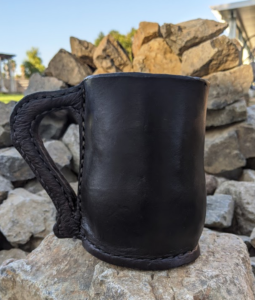
What is the entry?: English BlackJack
Where would it be found?: English Taverns 14th through 18th Centuries
What materials did you use?: Wood for the mold, Leather, Rabbit skin glue, artificial sinew thread, carbon black for dye, beeswax, and brewers pitch
What was your source of inspiration for this entry?: Black Jacks and leather bottells by Oliver Baker
Documentation: https://drive.google.com/file/d/1INDNNk30Qe8ABjswvU6w3J-I_VpsTx4W/view?usp=sharing

What is the entry?: 14th century German brick stitch reliquary bag
Where would it be found?: Collegiate Church of Soignies in Belgium
What materials did you use?: 28 count evenweave linen ground fabric, silk embroidery thread, linen sewing thread, silk dupioni for lining
What was your source of inspiration for this entry?: Extant reliquary bag at the Collegiate Church of Soignies in Belgium. The inital idea for the project was inspired by an A&S challenge issued by Master Bartholomew Hightower
Documentation: https://drive.google.com/file/d/19Pk-e6tVNhJVF64tP5LMQuWV-l-0gcpp/view?usp=sharing

What is the entry?: Set of 6 wire woven largesse bracelets
Where would it be found?: Adapted from wire woven cords and caged wire beads found in Birka, Sweden.
What materials did you use?: Silverplate, glass beads.
What was your source of inspiration for this entry?: These are adaptations of grave goods from ninth and tenth century Birka, Sweden. The inspiration for this particular adaptation is the spirit of welcoming newcomers. The Society’s custom about unadorned chains often needs to be explained to newcomers. It seems gracious to offer them a gift: an adornment for their chain. Each of these bracelets has a detachable charm: a caged bead in blue glass covered with silver plated wire on a lobster claw clasp. The bracelets can be worn with or without the charm. The idea is to have several people at events who can welcome a newcomer with a small present in symbolic heraldic colors so that instead of a reprimand the the new person comes away with a keepsake.
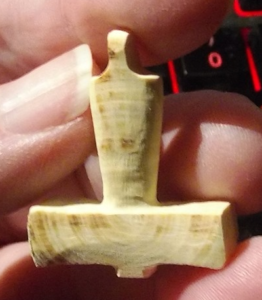

What is the entry?: Mjölnir
Where would it be found?: This is a wooden copy (casting positive) for a silver artifact from Läby, Uppland, Sweden.
What materials did you use?: citrus wood
What was your source of inspiration for this entry?: This particular historic mjölnir has not been widely copied by modern artisans.
Original hosting of the artifact sketch:
https://commons.wikimedia.org/wiki/Category:Archaeological_record_of_Mj%C3%B6llnir#/media/File:Torshammare_av_silver_fr_L%C3%A4by,_Uppland_(Montelius_1877_sid_348_fig_404).jpg
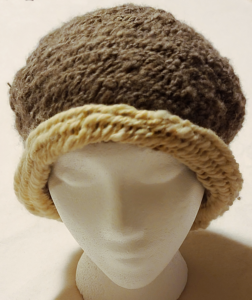
What is the entry?: Nalebinding Cap
Where would it be found?: Western Scandinavia
What materials did you use?: Finn wool
What was your source of inspiration for this entry?: Wanted to take a project from sheep to garment using a heritage breed (non-Merino) wool appropriate to early period Scandinavia. Spun this and plied it on my Louet spinning wheel, then nalebinded it using the Oslo stitch. The two color effect comes from undyed fleece of different sheep.
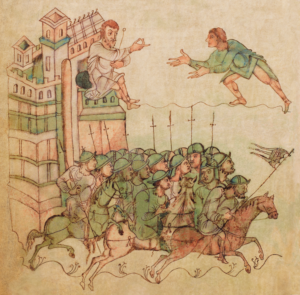
What is the entry?: Restored Carolingian Manuscript Illustration
Where would it be found?: Switzerland, originally near Lake Constance. City library of Bern.
What materials did you use?: Digital editing in GIMP software.
What was your source of inspiration for this entry?: Sometimes it is better to ask forgiveness than permission. This unorthodox entry is submitted in that spirit: since we are submitting entries digitally I have taken the liberty of doing a digital painting. It’s something I’ve wanted to do many times with the Society, yet other than a few newsletter illustrations there haven’t been opportunities.
https://commons.wikimedia.org/wiki/File:Fultondesign.jpg
https://www.e-codices.unifr.ch/en/searchresult/list/one/bbb/0264
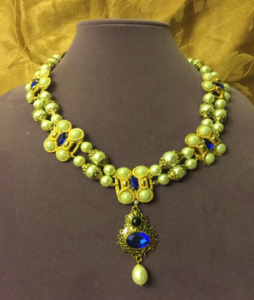
What is the entry?: 16th Century Spanish Collar (necklace)
Where would it be found?: In the possessions of a 16th century well-to-do Spanish woman
What materials did you use?: pot-metal plaques (repurposed), jewelry wire, pearls, blue stones, bead spacers, purchased pendant
What was your source of inspiration for this entry?: Jane Seymour by Hans Holbein, 1536 Enamel, Table-Cut Crystal and Pearl Necklace. c.1600, Italy. Victoria & Albert Museum Collection
https://en.wikipedia.org/wiki/File:Hans_Holbein_the_Younger_-
Jane_Seymour,_Queen_of_England_-_Google_Art_Project.jpg
and
Elizabeth de Valois by Juan Pantoja de la Cruz 1565
https://www.museodelprado.es/en/the-collection/art-work/queen-elisabeth-of-valois-third-wife-of-philip-ii/4bf43b3b-a3cf-44ef-aaf8-928b4ca51e0b
Documentation: https://drive.google.com/file/d/1MIBK5BQ8ZeqrtZjtiYuRj0UTZuv2Yqma/view?usp=sharing

What is the entry?: hat
Where would it be found?: This style of hat was endemic to all of Europe, I intend it to be worn with a 16th century Spanish gown.
What materials did you use?: read velvet, red silk (for lining), canvas (for interlining), a brooch and a number of small plaques.
What was your source of inspiration for this entry?: Maria of Austria, approx. 1555 by Hans Besser https://commons.wikimedia.org/wiki/File:Hans_Besser_001.jpg
Documentation: https://drive.google.com/file/d/1eTBTvyIkGMbtUgmX065JeB1Nx4KR9x0h/view?usp=sharing
